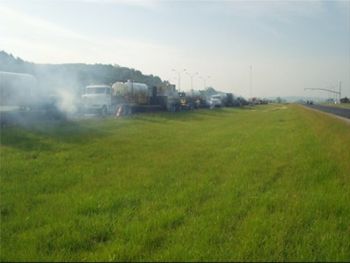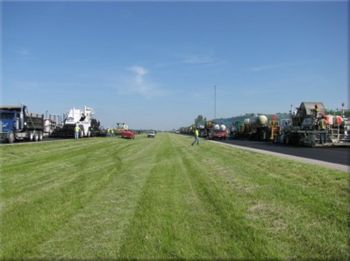Category:405 Processing Reclaimed Asphalt: Difference between revisions
m →405.3 Two Inch HIR (Use JSP-08-05): Updated JSP link |
mNo edit summary |
||
| Line 23: | Line 23: | ||
|[http://library.modot.mo.gov/RDT/reports/UnNumbrd/RAPBrief.pdf Summary, 1999] | |[http://library.modot.mo.gov/RDT/reports/UnNumbrd/RAPBrief.pdf Summary, 1999] | ||
|- | |- | ||
|'''See also:''' [ | |'''See also:''' [https://www.modot.org/research-publications Research Publications] | ||
|} | |} | ||
Hot In-Place Recycling (HIR) is the process of recycling the existing asphalt surface in a | Hot In-Place Recycling (HIR) is the process of recycling the existing asphalt surface in a | ||
Revision as of 15:01, 18 August 2020
To reuse milled material (also see Pavement and Bridge Surface Removal and Texturing), consider the following information and use the appropriate job special provision and pay items for liquid asphalt as described below.
405.1 Design
| Pavement, Cold In-Place Recycled Asphalt |
| Summary, 2010 |
| Summary, 2008 |
| Summary, 1999 |
| See also: Research Publications |
Hot In-Place Recycling (HIR) is the process of recycling the existing asphalt surface in a simultaneous, multi-step process of cleaning, heating, milling/scarifying, rejuvenating, spreading and leveling the recycled material. The placement and compaction of virgin hot mix asphalt material over the recycled surface may be accomplished simultaneously or with a separate paving operation. The process can be performed at one-inch or two-inch depths. The Construction and Materials Division will determine the appropriate projects, recycling thickness and appropriate virgin asphalt overlay mix type and thickness.
Typical candidates for HIR include oxidized asphalt pavements that contain a minimal number of concrete patches. If concrete patches exist they must be addressed by removing the top two or three inches of concrete and replacing it with hot mix asphalt (HMA).
| HIR Thickness | Concrete Removal Depth |
|---|---|
| 1 inch | 2 inches |
| 2 inches | 3 inches |
The HMA used to replace the concrete shall be either BP-1, BP-2, SP125 or commercial mix. The removal of concrete patches shall be addressed in either the same contract or prior to award of the contract.
The paving train utilized for HIR is very long; therefore, HIR should only be used on the mainline. Ramps, turn lanes, etc. should be addressed with conventional paving equipment. Typical recycling widths vary from twelve to fifteen feet depending on the width of the travel lane and the condition of the joint between the shoulder and the travel lane. Deteriorated joints should be included in the recycling limits. For pavements setup with rumble strips, establish the recycling width so that the underlying HIR joint is not under the rumble strip.
Tack coat is considered incidental to the HIR process. Therefore no quantity of tack coat should be set up for the area that is to be recycled. Tack coat should be used for other areas receiving a HMA overlay.
The contract should be structured as working day with a completion date.
All HIR projects should be setup as alternate bid. The Construction and Materials Division will determine the appropriate alternate.
405.2 One Inch HIR (Use JSP-04-12A)
The contract should be set up with pay items for Emulsified Asphalt, Hot In-Place Recycling by the gallon and 1 Inch, Hot In-Place Recycling by the square yard.
The estimate factor for the emulsified asphalt is 0.1 gal/yd2.
Typical production rate is 3 lane miles per day.
405.3 Two Inch HIR (Use JSP-08-05)
The contract should be set up with the following pay items: for Emulsified Asphalt, Hot In-Place Recycling by the gallon and 2 Inch, Hot In-Place Recycling by the square yard.
The estimate factor for the emulsified asphalt is 0.35 gal/yd2.
Typical production rate is 2 lane miles per day.


